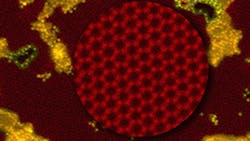Turning Bacterial Spores into Electromechanical Humidity Sensors
Scientists at University of Illinois at Chicago (UIC) are taking the unique approach of using the natural stimuli responses in bacterial spores to create high-accuracy humidity sensors. Spores have a hygroscopic membrane that allows water to flow in and out of the cell as the environmental humidity changes, making them magnitudes more responsive than polymers commonly used in humidity sensors.
By integrating graphene quantum dots (GQDs) on the surface of the spores, scientists can measure the changes in electron tunneling between each dot, or the bio-device’s conductivity, as the transmembrane hydraulic pressure causes the spore to shrink or expand. The spores could eventually be used in the human body to monitor organ function, cancer status, and hydration.
Osmosis, or the transport of water along a concentration gradient, occurs in living cells with a water-permeable membrane. Water osmoses from high to low water concentration, until equilibrium is achieved between bodies. So, the spore intakes water when the environmental water concentration becomes higher than that of the spore, and loses water when its water content is higher than that of the environment. All the while, hydraulic pressure relative to the spore’s interior and its environment increases as the spore expands, and decreases as the spore shrinks. The scientists were able to relate these changes in relative pressure to changes in conductivity.
The scientists placed a graphene-covered spore on a silica-on-silicone chip, spanning two gold/chromium electrodes, separated by 5 microns. They ran a bias voltage (35 meV) across the spore to spur electron transport between the graphene dots. The scientists varied humidity by passing N2 gas around the device. Meanwhile, they measured the change in conductivity due to the changes in electron tunneling distance between GQDs, as the spore shrank and expanded. As the spore shrinks, spacing between the GQDs also shrinks, facilitating the transport of electrons between dots.
In conclusion, a 300 Torr (about a thousandth of atmospheric pressure) change in relative pressure due to altering humidity causes a 1.63-nm change in electron tunneling between graphene dots. This yields an impressive five-fold change in conductivity. Because spores are so responsive, they hold lots of potential as bio-electromechanical humidity sensors.
Click here to read the scientific article in the online journal, Scientific Reports.
Attaching a Uniform Layer of GQDs |
|
Graphene is a thin sheet of sp2-hybridized carbon atoms. Each carbon atom has two single bonds to a carbon atom, and one double bond to another carbon atom, giving graphene a honeycomb-pattern. This hybridization allows for free flow of electrons between carbon atoms, making graphene a good conductor. A single-carbon-layer sheet of graphene can react with chemicals from both sides because of its 2D structure. The edges of a graphene array are especially reactive, increasing its ability to be altered for integration into the spore’s protective layer. Working at the nanoscale level, scientists had to make several chemical alterations to the surface of the GQDs for guaranteed attachment to the spore’s protective layer. They needed to alter the GQDs to bond with the bacterial spore’s surface, made up of cross-linked N-acetylmuramic (NAM) acid and N-acetylglucosamine (NAG). After cleaving graphene nanoribbons into GQDs using a diamond blade (sharp enough to cut things on the nanoscale), the GDQs were oxidatively cleaved in acid, producing EfGQDs, graphene quantum dots with negatively charged functional groups. The EfGQDs were then exposed to positively charged poly-L-lysine, which in turn, bonded with the negative functional groups. The resulting graphene was dubbed pLGQDs. The new poly-L-lysine functional groups have an electrostatic attraction to the NAM molecules on the spore’s protective layer, dispersing them evenly across the uniform NAM-NAG matrix. The end result is a spore covered in a network of pLGQDs: a graphenic cytobot, or a biohybrid tunneling device. The pLGQDs (referred to as GDQs in the article, for simplicity) are of low density, enabling normal water transport. |
About the Author
Leah Scully
Associate Content Producer
Leah Scully is a graduate of The College of New Jersey. She has a BS degree in Biomedical Engineering with a mechanical specialization. Leah is responsible for Machine Design’s news items that cover industry trends, research, and applied science and engineering, along with product galleries. Visit her on Facebook, or view her profile on LinkedIn.
